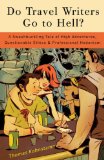Submitted by Nikki on
While traveling a few years ago in Central America, it seems every other gringo had their nose tucked into the thick green-covered travel bible, also know at Lonely Planet's Central America on a Shoestring. Travelers often ended up at the same hotels, same restaurants, and going to the same recommended cities in a vicious gringo circle of travel bliss. The off-the-beaten-path fame the guidebook once had is now the dominant guidebook for independent travelers, limiting the spectrum of the travel experience. Although I used to strictly stick to guidebook recommendations, I learned the hard way that their information was often out of date or completely wrong.
Thus the inspiration for Do Travel Writers Go to Hell? a travelogue written by former Lonely Planet writer Thomas Kohnstamm. The book reports the (debatable) impossibility of LP travel writers to accurately update, revise and add new material to guidebooks given the typical budget, time, and sheer distance they cover on a specific project. Although I don't recommend purchasing or reading the book (it's hard to feel sorry for the guy given the time he spends being a complete travel hedonist), he makes a good point about how travel guides shape the industry and how travelers take their word as gold.
It is my hope that this book will help demystify the origins of travel writing and show that when thousands of travelers follow a guidebook word-for-word, recommendation-for-recommendation, it not only harms contemporary international travel but can also do serious harm to places in the developing country. Thomas Kohnstamm (from Introduction to Do Travel Writers Go to Hell?)
- Log in to post comments

